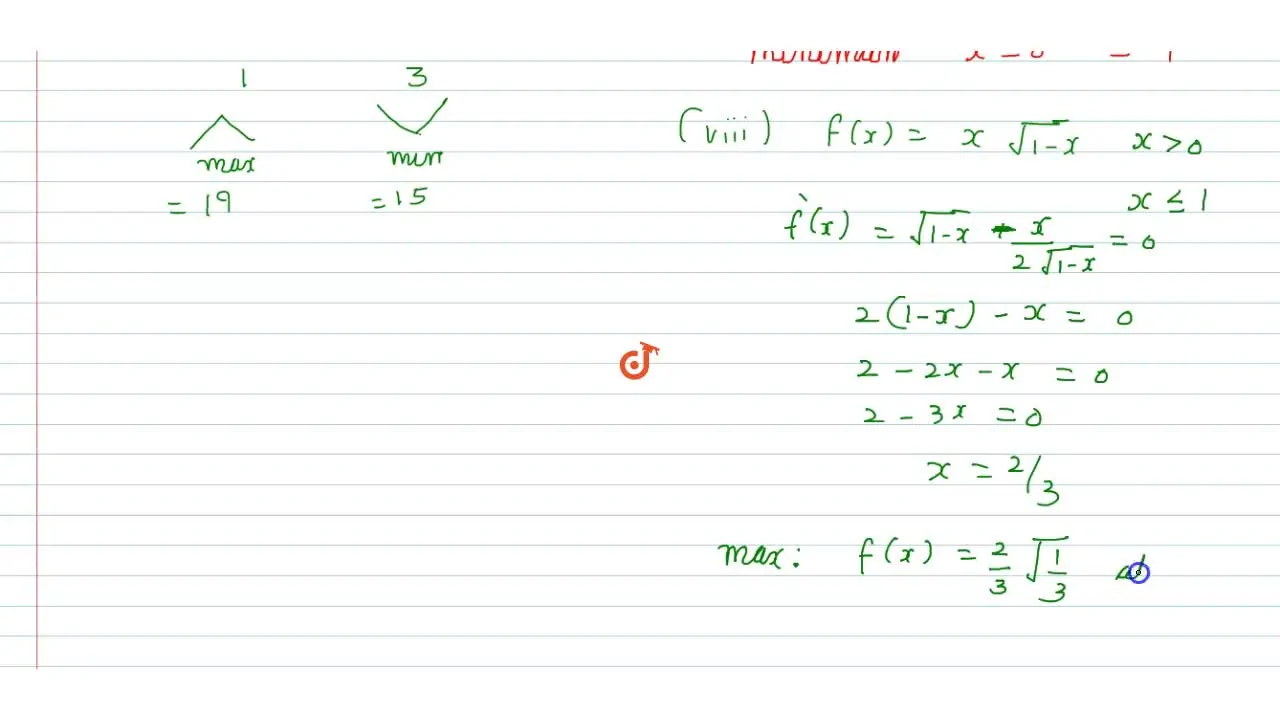Find the local maxima and local minima, if any, of the following functions. Find also the local maximum and the local minimum values, as the case may be:
(i)
(ii)
(iii)
(iv),
(v) f(x) =
(vi) g(x) = ,
(vii) g(x) =
(viii) ,
(i)
is critical point of function
At , Minimum value of function=0
(ii)
is the critical point of function
Now,
, is local minima point
, is local maxima point
Maximum value at should be
Minimum value at should be
(iii)
maximum=
minimum=
But in this case ,
minimum at x=0 should be 1.
(iv)
Getting,
i.e., is negative, so at is local maxima
Hence, local maximum value =
is positive so is local minima
Hence, local minimum value =
(v)
Now,
Therefore , by second derivative test , is a point of local maxima and the local maximum value of f at at
However, x=3 is a point of local minima and the local minimum value of f at is
(vi)
Now, gives
Since , we take
Now,
Therefore, by second derivative test, is a point of local minima and the local minimum value of g at is
(vii)
Now for values close to and to the left of 0 , Also, for values close to x=0 and to the right of 0,
Therefore, by first derivative test, is a point of local maxima and the local maximum value of is
Related Playlists
- BOOK - NCERTCHAPTER - APPLICATION OF DERIVATIVESEXERCISE - EXERCISE 6.219videos
APPLICATION OF DERIVATIVES
- BOOK - NCERTCHAPTER - APPLICATION OF DERIVATIVESEXERCISE - EXERCISE 6.118videos
APPLICATION OF DERIVATIVES
- BOOK - NCERTCHAPTER - APPLICATION OF DERIVATIVESEXERCISE - EXERCISE 6.49videos
APPLICATION OF DERIVATIVES
- BOOK - NCERTCHAPTER - APPLICATION OF INTEGRALSEXERCISE - EXERCISE 8.27videos
APPLICATION OF INTEGRALS
Similar Questions
Find the local maxima and local minima, if any, of the followig functions. Find also the local maximum and the local minimum values, as the case may be :
f(x)=x2View SolutionFind the local maxima and local minima, if any, of the followig functions. Find also the local maximum and the local minimum values, as the case may be :
g(x)=x3−3xView SolutionFind the local maxima and local minima, if any, of the followig functions. Find also the local maximum and the local minimum values, as the case may be :
g(x)=1x2+2View SolutionFind the local maxima and local minima, if any, of the followig functions. Find also the local maximum and the local minimum values, as the case may be :
f(x)=x3−6x2+9x+15View SolutionFind the local maxima and local minima, if any, of the followig functions. Find also the local maximum and the local minimum values, as the case may be :
f(x)=x√1−x,x>0View SolutionFind the local maxima and local minima, if any, of the followig functions. Find also the local maximum and the local minimum values, as the case may be :
f(x)=sinx−cosx,0<x<2πView SolutionFind the local maxima and local minima, if any, of the followig functions. Find also the local maximum and the local minimum values, as the case may be :
f(x)=sinx−cosx,0<x<2πView SolutionFind the local maxima and local minima, if any, of the followig functions. Find also the local maximum and the local minimum values, as the case may be :
g(x)=x2+2x,x>0View SolutionFind the local maxima and local minima, if any, of the followig functions. Find also the local maximum and the local minimum values, as the case may be :
h(x)=sinx+cosx,0<x<π2View SolutionFind the local maxima and local minima, if any, of the following functions. Find also the local maximum and the local minimum values, as the case may be:
(i)f(x)=x2
(ii)g(x)=x3−3x
(iii)h(x)=sinx+cosx,0<x<π2
(iv)f(x)=sinx−cosx,0<x<2π
(v)f(x)=x3−6x2+9x+15
(vi)g(x)=x2+2x,x>0
(vii)g(x)=1x2+2
(viii)f(x)=x√1−x,0<x<1View Solution


